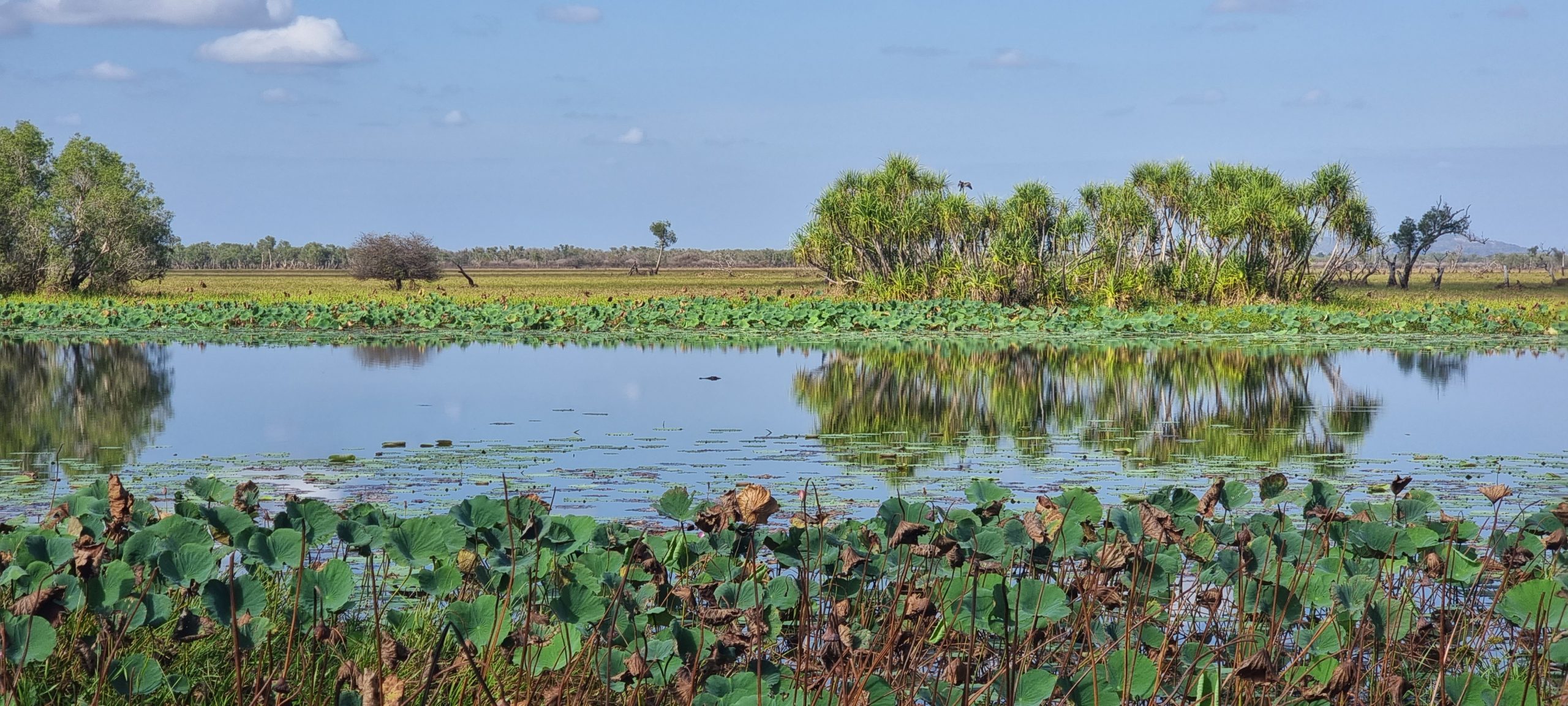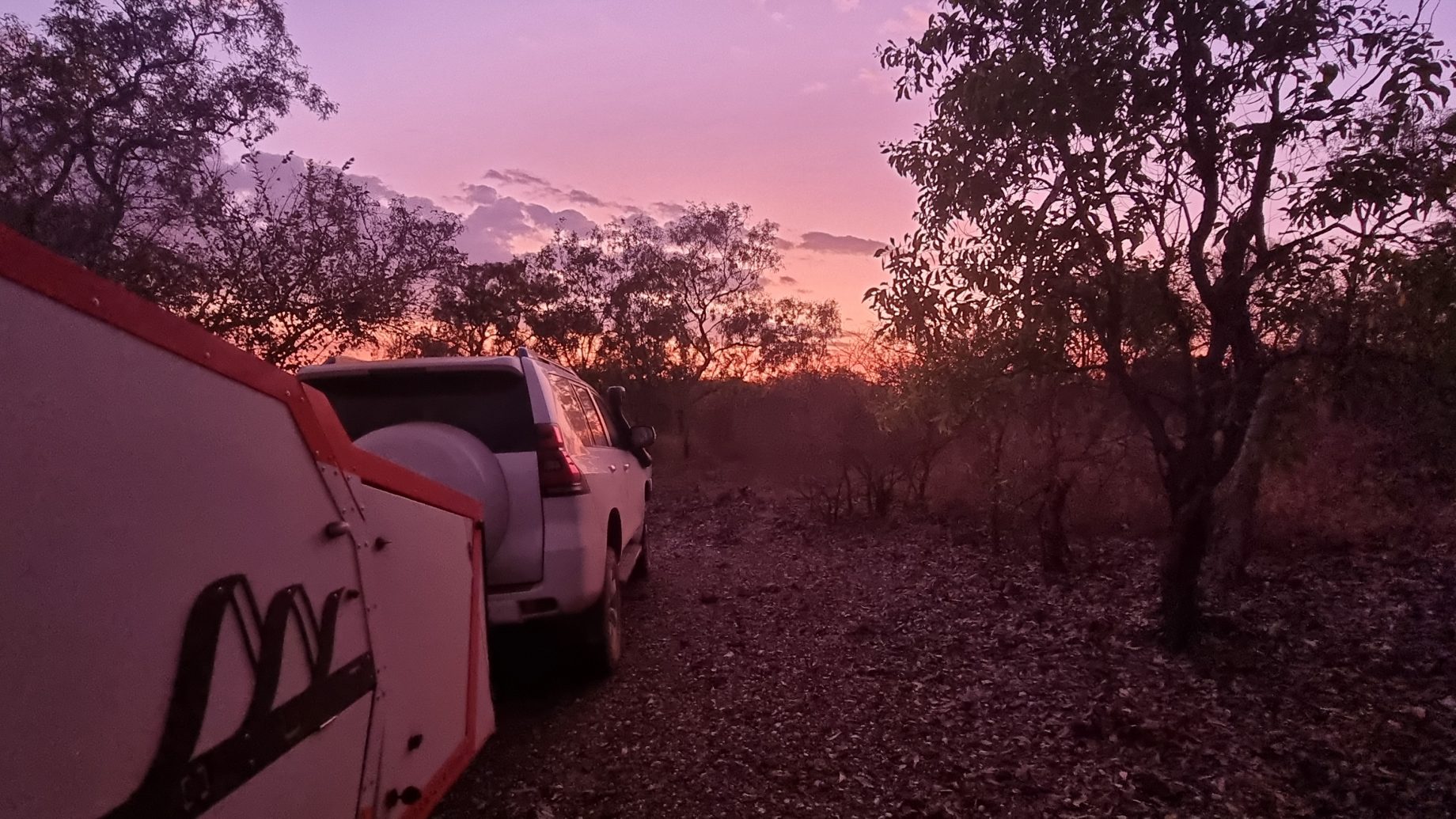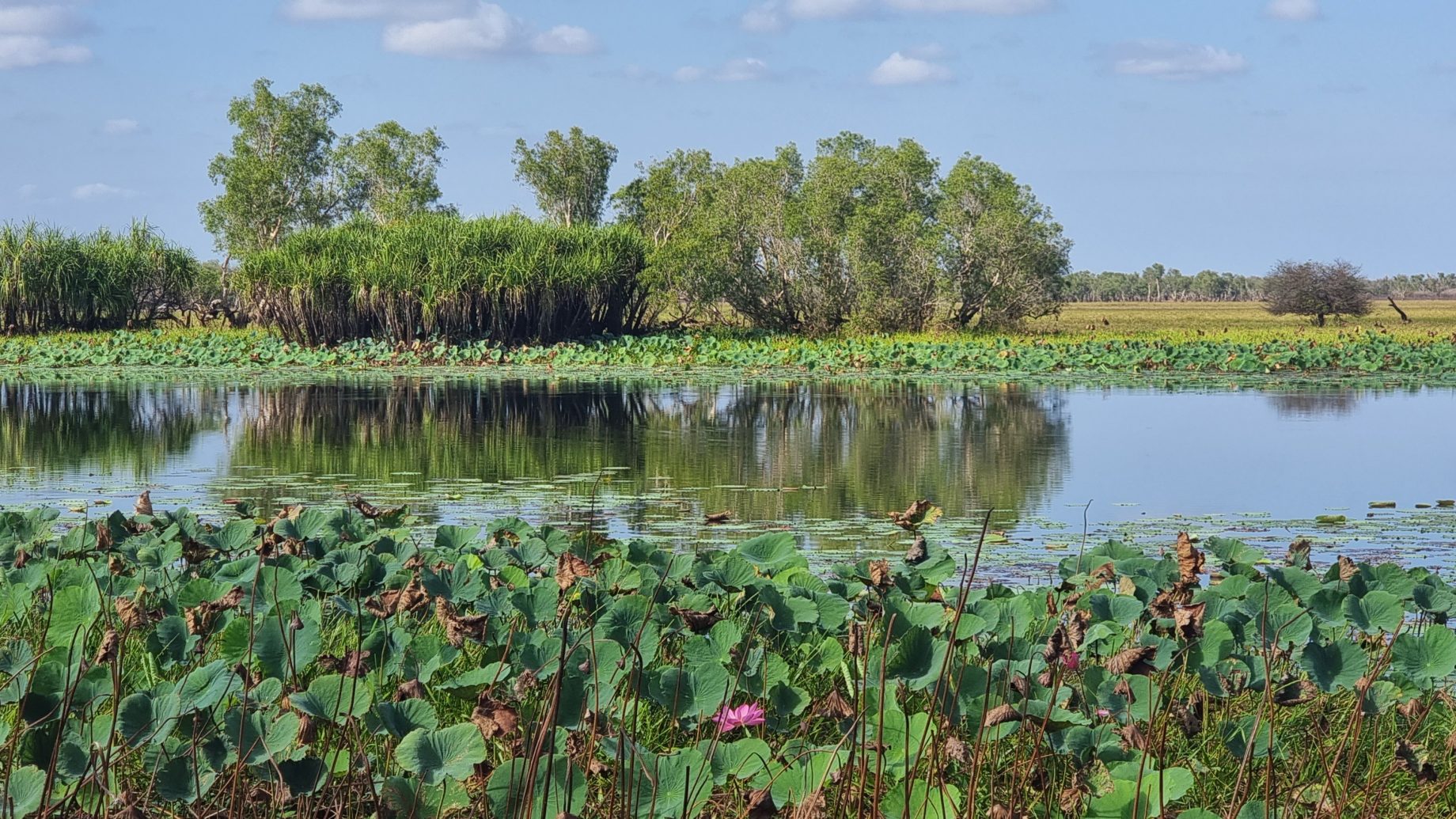Wednesday, 3rd August
Today was our last day in Kakadu. We had ticked off most of the things we wanted to do on this visit and found other places we might explore on future visits. Our very small taste of Arnhem Land has heightened our interest in returning one day and possibly exploring the Cobourg Peninsula – the site of the first European settlement in this part of the country before Darwin was founded.
The mornings are best for packing up, as the heat and humidity have yet to increase to uncomfortable levels and the ratio of insects to people has not yet tipped in favour of the insects. In departing, we drove around a German family who had set up their table and chairs over much of the track leading to our campsite. The familiar drive back to Jabiru took little time; we completed the usual chores there and again made use of their excellent mobile phone coverage before pushing on to our next campsite beside the Mary River.
The drive west along the Arnhem Highway crosses a number of major river systems before you finally leave Kakadu National Park behind. Interestingly, the rivers are mis-named. Apparently one of the first explorers through the region was familiar with alligators, but had never heard of crocodiles – so he went ahead and named the East Alligator, the South Alligator and the West Alligator rivers. There is also the Wildman river to cross on the way to the Mary River. All these river systems include extensive wetland areas that would be inundated in the wet season, then drain into the rivers as the dry season takes hold. These wetlands are home to millions of migratory birds throughout the year; the magpie geese are just starting to arrive in preparation for the wet season buildup and their mating season.
The Mary River National Park takes in much of the river and wetlands to the north of the Arnhem Highway through to the coast (at Point Stuart) – where John McDouall Stuart completed his south-to-north transit of the country in 1861 before returning to Adelaide and officially becoming the first European explorer to do so. The drive in to the campground was initially on a good sealed road for the first 17 kilometres, before turning to a reasonable, graded gravel road for the final 20 kilometres. The campsites are positioned along a loop road where some sites have great views out over the river while others are tucked away in the bush back from the water. Wendy had done her research and selected a site on the high side of the road with great views out over the river and surrounding wetlands.


Setting up took a little while, as we struggled to find a level patch of ground on our site. With everything eventually in place we had the chance to sit back and watch the world go by. We have watched crocs drift by in pursuit of a meal. Later in the day we watched as feral cattle wandered out of the bush that rings the wetlands to graze on the lush green grasses that have been receiving a lot of water. These cattle were followed by later in the afternoon by two water buffalo – easily spotted due to their size, colour and distinctive horns that arc back towards their rear.
As dusk approached, Chris lit a fire in the hope it may deter the insects that seem to appear as the sun disappears below the horizon. With overnight temperatures dropping to 20C, a fire for heat wasn’t really necessary but hopefully (we thought) the smoke might make it more comfortable to sit outside as the day drew to a close. It wasn’t to be. Within minutes of the sun disappearing, the insects of the night were stirred into action. Mosquitoes in significant numbers appeared, and all were seeking blood. The night air was filled with the buzzing sound of insects either seeking a victim or hovering around the light over our kitchen waiting for a victim to approach.
Dinner and washing up was therefore done in haste, as we decided to call it a day and retreat inside the Tvan where we could escape the insect attack. All the insect screens were secured before a long and thorough blast of mozzie spray was dispatched into every corner of the Tvan.
So what did we learn during our time in Kakadu?
- Jabiru is Dutch for stork
- Jabiru use the same nest over and over until it collapses under the weight of their own excrement
- there are more mosquitos in the northern parts of Kakadu than further south
- Magpie geese and buffalo are ”good tucker”
- most visitors show respect when visiting important cultural sites.
Thursday, 4th August
It was a hot night with the minimum getting down to 21C just before dawn. Chris was up and off to take some photos pretty quickly as the wetlands were blanketed in fog. He ventured down closer to the edge of the billabong to get a better view of the scenery to the west. On his return he confirm he had one eye on the viewfinder and the other on the waters edge. within 30 minutes the fog had been burnt off and the scene we had grown familiar with yesterday had returned. we both enjoyed the cooler morning air and the general absence of annoying insects.
There is an area of land to the south of the national park designated as a military training ground. Throughout the night we heard a number of helicopters and aircraft overhead and assumed some training exercise was underway. It would be a tough area to train in given all the native and feral animals in the area all out to eat or kill intruders. We read something online a few days ago about joint training exercises taking place with other military personnel from the regioin.
After a leisurely breakfast we set off for a walk through the campground and over to the day use are where Couzens Lookout is located . we spent some time gazing at the billabong from the lookout unitl another croc came into view. It was very slowly drifting upstream with often little more than its nose above water. Sometimes it would disappaear completely before gradually returning to the surface and continuing upstream. We watched two darters splashing about in the river and wondered whether that was a wise thing to do in this river.


A large ”expedition truck” pulled up in front of our site blocking some of the stunning view we have out over the wetlands. They set up and have since spent the entire day inside their truck / home. They appear to have spent much of the time on the phone trying to get something fixed on their truck.
The day heated up after lunch with 33.9C (feels like 35.2C) being reported on the BOM website. We stayed in the shade and drank plenty of fluids and read a lot as the afternoon passed. The feral cattle and water buffalo emerged from out of the bush surrounding the wetlands late in the afternoon again. We guessed it may be so they can stay in the shade during the heat of the day and only when it stats to cool is it time to graze in the open. We had learnt our lesson the previous evening that we needed to have dinner early and retire inside before dark when the mosquitos emerge. we got the timing right and managed to avoid become a meal for the rampaging hoards.

